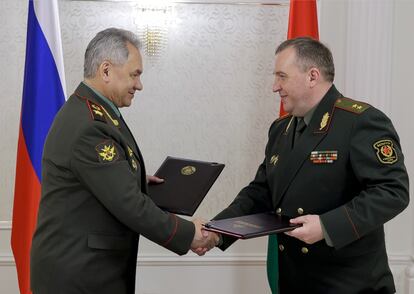Russia signs deal to deploy tactical nuclear weapons in Belarus
When the weapons would be deployed remains unknown, but Russian President Vladimir Putin has said that the construction of storage facilities for the weapons in Belarus would be completed by July

Russia and Belarus signed a deal Thursday formalizing the deployment of Moscow’s tactical nuclear weapons on the territory of its ally, although control of the weapons remains in the Kremlin. Russian President Vladimir Putin announced the deployment of the shorter-range weapons in Belarus earlier this year in a move widely seen as a warning to the West as it stepped up military support for Ukraine.
When the weapons would be deployed wasn’t announced, but Putin has said the construction of storage facilities in Belarus for them would be completed by July 1.
Also unclear is how many nuclear weapons would be kept in Belarus. The U.S. government believes Russia has about 2,000 tactical nuclear weapons, which include bombs that can be carried by aircraft, warheads for short-range missiles and artillery rounds.
Tactical nuclear weapons are intended to destroy enemy troops and weapons on the battlefield. They have a relatively short range and a much lower yield than nuclear warheads fitted to long-range strategic missiles that are capable of obliterating whole cities.
The signing of the deal came as Russia braces for Ukraine’s much-anticipated counteroffensive. Both Russian and Belarusian officials also framed the step as driven by hostility from the West.
“Deployment of nonstrategic nuclear weapons is an effective response to the aggressive policy of countries unfriendly to us,” Belarusian Defense Minister Viktor Khrenin said in Minsk at a meeting with his Russian counterpart, Sergei Shoigu.
“In the context of an extremely sharp escalation of threats on the western borders of Russia and Belarus, a decision was made to take countermeasures in the military-nuclear sphere,” Shoigu added.
Putin has argued that by deploying its tactical nuclear weapons in Belarus, Russia was following the lead of the United States, noting that the U.S. has nuclear weapons based in Belgium, Germany, Italy, the Netherlands and Turkey.
Exiled Belarusian opposition leader Sviatlana Tsikhanouskaya condemned the move.
“We must do everything to prevent Putin’s plan to deploy nuclear weapons in Belarus, as this will ensure Russia’s control over Belarus for years to come,” Tsikhanouskaya told The Associated Press. “This will further jeopardize the security of Ukraine and all of Europe.”
Independent Belarusian military analyst Aliaksandr Alesin said about two-thirds of Russia’s arsenal of medium-range nuclear-tipped missiles were held in Belarus during the Cold War, adding that there are dozens of Soviet-era storage facilities that could still be used.
Soviet nuclear weapons stationed in Belarus, Ukraine, and Kazakhstan were moved to Russia in a U.S.-brokered deal after the dissolution of the Soviet Union in 1991.
“Documents in Minsk on the return of nuclear weapons were defiantly signed just at the moment when Ukraine declared a counteroffensive and Western countries are handing over weapons to Kyiv,” Alesin told the AP.
“This Belarusian nuclear balcony should spoil the mood for politicians in the West, since nuclear missiles are capable of covering Ukraine, all of Poland, the Baltic states and parts of Germany.”
Khrenin also announced plans to “build up the combat potential of the regional grouping of Russia and Belarusian troops,” including the transfer to Minsk of the Iskander-M missile system, capable of carrying a nuclear charge, and the S-400 anti-aircraft missile system.
Russia and Belarus have an alliance agreement under which the Kremlin subsidizes the Belarusian economy, via loans and discounted Russian oil and gas. Russia used Belarusian territory as a staging ground for invading neighboring Ukraine and has maintained a contingent of troops and weapons there.
Sign up for our weekly newsletter to get more English-language news coverage from EL PAÍS USA Edition
Tu suscripción se está usando en otro dispositivo
¿Quieres añadir otro usuario a tu suscripción?
Si continúas leyendo en este dispositivo, no se podrá leer en el otro.
FlechaTu suscripción se está usando en otro dispositivo y solo puedes acceder a EL PAÍS desde un dispositivo a la vez.
Si quieres compartir tu cuenta, cambia tu suscripción a la modalidad Premium, así podrás añadir otro usuario. Cada uno accederá con su propia cuenta de email, lo que os permitirá personalizar vuestra experiencia en EL PAÍS.
¿Tienes una suscripción de empresa? Accede aquí para contratar más cuentas.
En el caso de no saber quién está usando tu cuenta, te recomendamos cambiar tu contraseña aquí.
Si decides continuar compartiendo tu cuenta, este mensaje se mostrará en tu dispositivo y en el de la otra persona que está usando tu cuenta de forma indefinida, afectando a tu experiencia de lectura. Puedes consultar aquí los términos y condiciones de la suscripción digital.
More information

Russia might put strategic nukes in Belarus
Archived In
Últimas noticias
Most viewed
- Reinhard Genzel, Nobel laureate in physics: ‘One-minute videos will never give you the truth’
- Oona Chaplin: ‘I told James Cameron that I was living in a treehouse and starting a permaculture project with a friend’
- Pablo Escobar’s hippos: A serious environmental problem, 40 years on
- Why we lost the habit of sleeping in two segments and how that changed our sense of time
- Chevy Chase, the beloved comedian who was a monster off camera: ‘Not everyone hated him, just the people who’ve worked with him’









































